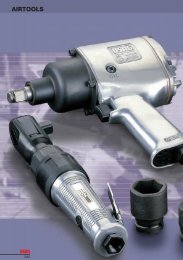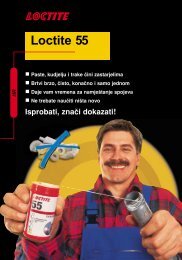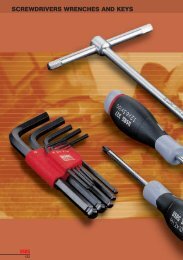Industrial seal self study guide - SKF.com
Industrial seal self study guide - SKF.com
Industrial seal self study guide - SKF.com
Create successful ePaper yourself
Turn your PDF publications into a flip-book with our unique Google optimized e-Paper software.
Seal Applications (cont.)<br />
°C °F<br />
260° 500°<br />
400°<br />
200°<br />
300°<br />
100° 200°<br />
100°<br />
0°<br />
32°<br />
0°<br />
-100°<br />
-100°<br />
-240° -400°<br />
PTFE<br />
Viton<br />
Silicone<br />
Polyacrylate<br />
Leather<br />
Duralip<br />
Nitrile<br />
Duratemp<br />
Lip materials’ maximum operating<br />
temperatures fall within these<br />
ranges (fig. 4l).<br />
Material Capabilities—Temperature Resistance<br />
In performing their <strong>seal</strong>ing function, <strong>seal</strong> lip materials work best within<br />
the following temperature ranges. (Also see fig. 4l).<br />
Polytetrafluoroethylene<br />
(PTFE) -400˚ to 500˚ -240˚ to 260˚<br />
Fluoroelastomer -40˚ to 400˚ -40˚ to 204˚<br />
(LongLife)<br />
Silicone -100˚ to 325˚ -73˚ to 163˚<br />
Polyacrylate -40˚ to 300˚ -40 to 149˚<br />
Duralip -40˚ to 250˚ -40 to 121˚<br />
Nitrile -40˚ to 250˚ -40 to 121˚<br />
Leather -100˚ to 200˚ -73˚ to 93˚<br />
Duratemp -40˚ to 300˚ -40˚ to 149˚<br />
F˚<br />
C˚<br />
Low temperatures can be as much of a problem for a <strong>seal</strong> as high<br />
temperatures. At low temperatures the <strong>seal</strong>ing material gets stiff<br />
and rigid. That causes several problems. The <strong>seal</strong>ing lip has trouble<br />
following the eccentricity of a shaft that’s not perfectly true. That causes<br />
it to leak every time the shaft rotates “off center” and pulls away from<br />
the <strong>seal</strong>. If it gets stiff enough, the material be<strong>com</strong>es brittle and breaks<br />
up with the movement of the shaft. Another problem can appear when<br />
the lip material starts to shrink up at low temperatures.<br />
At high temperatures, some elastomers will continue to cure again<br />
and lose their pliability. If the temperature gets high enough to burn the<br />
lip material, it often be<strong>com</strong>es hard and brittle. It can crack and break up.<br />
In such cases, it not only loses its <strong>seal</strong>ing effectiveness, it can also<br />
damage the bearing and the shaft it was designed to protect.<br />
Consequently, both upper and lower operating temperature limits<br />
should be considered when choosing a lip material. See fig. 4l for<br />
operating temperature ranges of a variety of lip materials.<br />
42







